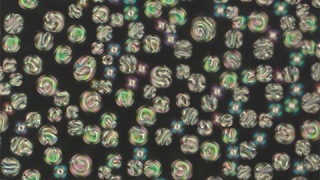Feb 5 2018
A research team from Kirensky Institute of Physics of the Siberian Branch of Russian Academy of Science and Siberian Federal University (SibFU) has partnered with Russian and foreign counterparts to investigate the droplets of a cholesteric liquid crystal with a twisted defect loop. The outcomes of the research have been reported in the journal Scientific Reports.
 Droplets of a cholesteric liquid crystal as viewed through a polarizing microscope. (Image credit: Mikhail Krakhalev)
Droplets of a cholesteric liquid crystal as viewed through a polarizing microscope. (Image credit: Mikhail Krakhalev)
Liquid crystals (LCs) are compounds that move into the mesophase - the state between solid matter and liquid matter - at a specific range of temperatures. Liquid crystals include two conflicting characteristics: their fluidity is similar to that of liquids and their anisotropy of physical characteristics (the difference in characteristics based on direction) is similar to that of solid crystals. These distinctive features are accounted for by orientational order of long molecular axes.
Consequently, although the molecules in an LC stay comparatively mobile, they are oriented in a specific manner regulating anisotropy of characteristics. Molecules might have distinctive orientation, and it may get modified under the impact of an electric field. This is the reason behind the wide-scale usage of LCs in electrical optic devices (for example, display screens).
The researchers analyzed liquid crystals known as chiral nematics or cholesterics. There are a number of rotation axes for each molecule of a liquid crystal. In orientation structures, a principal direction of long molecular axes is known as a director. In cholesterics, a twisted helical structure is formed by the director, indicating that the directions of long molecular axes - and hence their dipole moment - are rotated opposing one another at a specific angle and their ends demarcate a spiral line, or a helix, surrounding the axis of the helicoid.
The strange orientation of LC molecules results in spatial modulation of refraction index of a cholesteric, that is, it gets modified harmonically. When light passes through such a structure, it gets diffracted. The characteristic of propagation of light through a cholesteric LC is governed by the parameters of the helical orientation structure that are based on the characteristics of the liquid crystal and the type of its interaction with the surroundings.
The researchers investigated a cholesteric LC’s structure in droplets with a size of tens of microns and including perpendicular directors at the frontier with polymer. As it transpired, the helical structure in several parts of droplets had distinctive helix pitch, or the distances at which the director made a full turn.
“We’ve studied the structure formed in the droplets of a cholesteric LC in detail, and showed how the droplets look at different aspect directions and droplet sizes using an optical microscope. We’ve also studied the influence of an electric field on the periodicity structure and the shape of linear defect,” stated Mikhail Krakhalev, a co-author of the study, a candidate of physical and mathematical sciences, senior scientific associate of Kirensky Institute of Physics, and the dean of the Chair of General Physics at the Institute of Engineering Physics and Radio Electronics, SibFU.
The scientists demonstrated that a defect in the form of a twisted double helix is formed in the cholesteric droplets. The researchers also investigated the optic compositions of such structures that could be viewed through an optical microscope. As the structures formed in cholesteric droplets are highly complicated, respective optic textures are ascertained by a larger number of factors.
We’ve studied and described the correlation between the optical texture of the droplets and their size and the aspect directions. The described structures may help identify similar configurations in other systems, and the approach suggested by us may be used to analyze complex orientation structures.
Mikhail Krakhalev, Co-Author
The study was the fruit of a partnership between researchers from Kirensky Institute of Physics of the Siberian Branch of Russian Academy of Science, Lomonosov Moscow State University, and National Cheng Kung University (Taiwan).